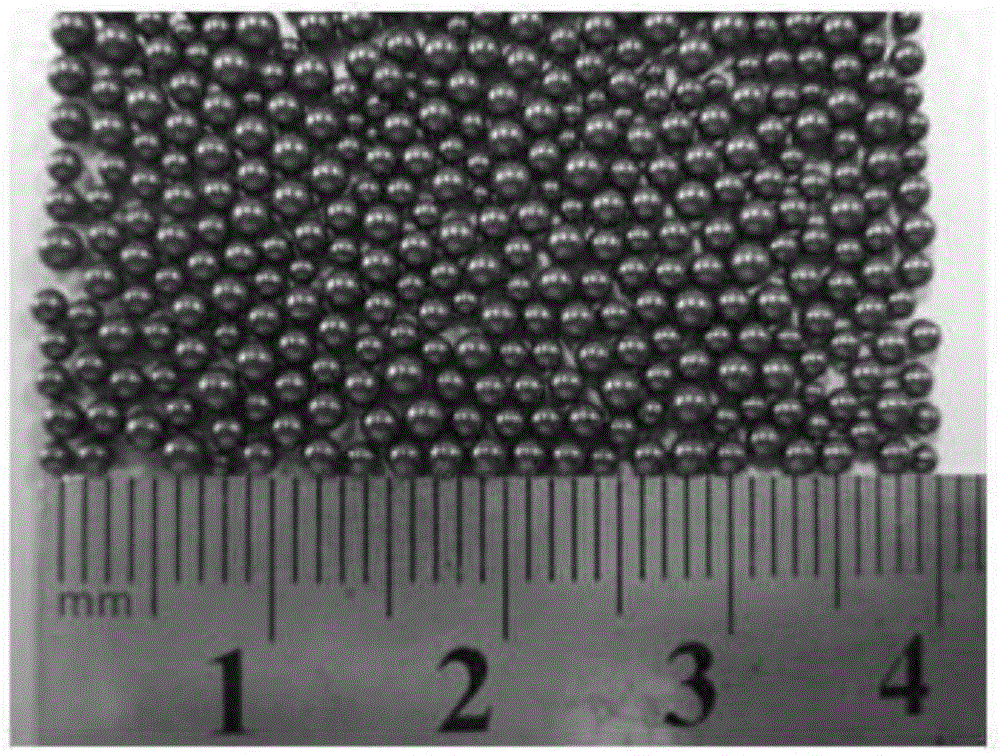Water-phase suspension granulation method for preparing gradient flame-retardant foamable polystyrene beads on basis of waste polystyrene materials and products of water-phase suspension granulation method
A foamed polystyrene and waste polystyrene technology, which is applied in the field of high-value recycling of waste polystyrene foam materials, can solve the problems of high recycling cost, poor application prospects, secondary pollution, etc. Combustion performance and thermal insulation performance, easy industrial production and application, good thermal insulation performance
- Summary
- Abstract
- Description
- Claims
- Application Information
AI Technical Summary
Problems solved by technology
Method used
Image
Examples
Embodiment 1
[0032] 1) Construction of inorganic-organic gradient synergistic flame retardant and heat insulation system
[0033] 1a) Modification of inorganic flame retardant-heat insulation system
[0034] Add 150ml of deionized water and 1.2g of polyvinylpyrrolidone to the container in turn. After dissolving, add 2.0g of nano-magnesium hydroxide, 2.0g of nano-aluminum hydroxide, 2.0g of nano-zinc borate, 2.0g of ammonium polyphosphate, and 2.0g of hydrotalcite , 2.0g of graphite thermal insulation agent with an average particle size of 5um, ultrasonically dispersed for 8min, mechanically stirred at a speed of 180rpm, heated in a water bath to 73°C, added 2.0g of hydrophobic modifier polyethylene glycol phosphate, reacted for 1.0h, pumped after cooling Filter, wash with ethanol, and dry to obtain a loose lipophilic inorganic flame retardant-heat insulation system.
[0035] 1b) Preparation of inorganic-organic gradient synergistic flame retardant insulation system
[0036] According to ...
Embodiment 2
[0044] 1) Construction of inorganic-organic gradient synergistic flame retardant and heat insulation system
[0045] 1a) Modification of inorganic flame retardant-heat insulation system
[0046] Add 150ml of deionized water and 1.5g of polyvinylpyrrolidone to the container in turn. After dissolving, add 3.0g of nano-magnesium hydroxide, 3.0g of nano-aluminum hydroxide, 3.0g of nano-zinc borate, 3.0g of ammonium polyphosphate, and 3.0g of hydrotalcite , 3.0g of graphite heat insulating agent with an average particle size of 5um, ultrasonically dispersed for 10min, mechanically stirred at a speed of 200rpm, heated in a water bath to 75°C, added 2.4g of hydrophobic modifier oleic acid, reacted for 1.0h, cooled and then filtered with ethanol After washing and drying, a loose lipophilic inorganic flame retardant-heat insulation system is obtained.
[0047] 1b) Preparation of inorganic-organic gradient synergistic flame retardant insulation system
[0048] According to the weight ...
Embodiment 3
[0056] 1) Construction of inorganic-organic gradient synergistic flame retardant and heat insulation system
[0057] 1a) Modification of inorganic flame retardant-heat insulation system
[0058] Add 350ml of deionized water and 2.5g of polyvinylpyrrolidone to the container in turn. After dissolving, add 4.0g of nano-magnesium hydroxide, 4.0g of nano-aluminum hydroxide, 4.0g of nano-zinc borate, 4.0g of ammonium polyphosphate, and 4.0g of hydrotalcite , 4.0g of graphite heat insulating agent with an average particle size of 5um, ultrasonically dispersed for 13min, mechanically stirred at a speed of 280rpm, heated in a water bath to 76°C, added 4.0g of hydrophobic modifier oleic acid, reacted for 1.2h, cooled and then filtered with ethanol After washing and drying, a loose lipophilic inorganic flame retardant-heat insulation system is obtained.
[0059] 1b) Preparation of inorganic-organic gradient synergistic flame retardant insulation system
[0060] According to the weight ...
PUM
 Login to View More
Login to View More Abstract
Description
Claims
Application Information
 Login to View More
Login to View More - R&D
- Intellectual Property
- Life Sciences
- Materials
- Tech Scout
- Unparalleled Data Quality
- Higher Quality Content
- 60% Fewer Hallucinations
Browse by: Latest US Patents, China's latest patents, Technical Efficacy Thesaurus, Application Domain, Technology Topic, Popular Technical Reports.
© 2025 PatSnap. All rights reserved.Legal|Privacy policy|Modern Slavery Act Transparency Statement|Sitemap|About US| Contact US: help@patsnap.com


